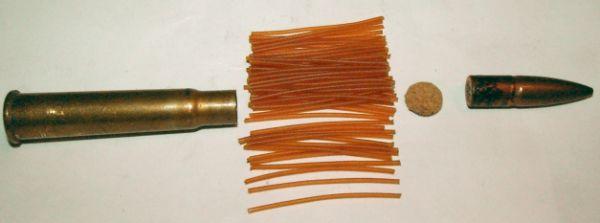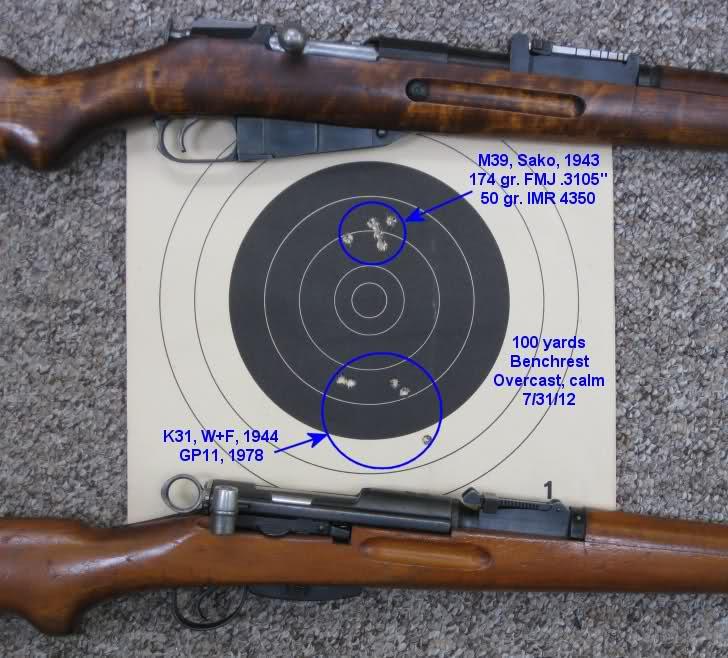-
FREE MEMBER
NO Posting or PM's Allowed

-
08-09-2016 11:52 AM
# ADS
Friends and Sponsors

-
Advisory Panel


-
The Following 4 Members Say Thank You to Parashooter For This Useful Post:
-
-
Legacy Member

Because most MN variants have a BORE diameter of close-enough to .300", they will also run happily with .308" bullets.
One trick I have seen, not actually owning one myself, is to load "surplus" 150gn., ball (FMJ), ex-30-06 type, and play with loads.
Yes, a .311"-.312" bullet may be ideal.
The Finns themselves seem keen on their "match" variant, the 7.62 x 53R, which is essentially a fancy load using .308" match bullets in the standard case (just use the appropriate expander ball / plug when case sizing). The Finn, Moisin Nagant-actioned, MATCH rifles for this are built with .308" groove barrels, but, plenty of people seem to mix and match. A good, clean M39 could be an eye-opener in this case.
The trusty old Lee Enfield .303 squirted .311" FB FMJ bullets out of barrels that regularly, and within spec., ran out to .319" / .320" groove diameter and could deliver some pretty impressive groups at 600 yards.
-
The Following 2 Members Say Thank You to Bruce_in_Oz For This Useful Post:
-
Advisory Panel


Given some of the assertions in the previous post, I suspect Bruce and others might find this old article interesting -
Attachment 75092Attachment 75093
-
The Following 2 Members Say Thank You to Parashooter For This Useful Post:
-
Legacy Member

I am keen on bullets that "fit" the groove size, even to the point of using "oversized" bullets on occasion; like "soft" .311 soft-points in a particular .30-06 that shot exceptionally well with them.
"Bore-riders" are not a new thing, as indicated by the longevity of the .303.
They may also not be an ideal thing, but you get that at times.
Furthermore, gas-bleed is MUCH greater with boat-tails of the solid based (like most "sporting" projectiles), than with "open-based", FLAT based FMJ types. Hit an "open-based" bullet up the rear end with 40,000 plus PSI and it is unlikely to stay at the original diameter for very long. Has anybody got the article, I think it was in the British "Guns Review", that detailed experiments with ULTRA short rifle barrels and reaming out the bore itself?
"Guns Review", that detailed experiments with ULTRA short rifle barrels and reaming out the bore itself?
My recollection is that the recovered bullets showed measurable expansion at their tail-end when fired in short, slightly-oversized, smooth-bored barrels. The rather rapid burn-rate of traditional Cordite may have been a contributing factor.
This feature is a direct carry over from the earlier, muzzle-loaded Minie ball of P-53 Enfield, etc., fame, i.e., a "bore-rider" with an expandable "skirt" that sealed the rear and also helped "scrape" out the residue from the previous shot. Earlier editions of this bullet design had a small "plug" inserted into the hollow base of the lead bullet. this was designed to be driven into the slightly-tapered recess on ignition and force the "skirt" out into the grooves. It didn't take long for someone to discover that this plug was not necessary as gas pressure, even from a black-powder load, was sufficient to do the job.
Going to the .577-450 Martini Henry bullet introduced a few new "funnies".
Henry's original bullet design tapered from .450" at the base to .439 near the nose. Experiments carried out by a certain Dr. Mann, from about 1890 to 1910, strongly indicated that the best bullet for black powder was a bore-rider, with a rear band increased to groove size.
Kynoch production up until the 1960s, kept this idea and their bullet measured .452 at the base and .446 at the nose. with a thin paper patch, this came out to .460" and .455 respectively.
Using more traditional "cartridge" paper, these days fashionably referred to as "artists" paper, the diameter at the base comes out to .470", conveniently assisting the fit of the bullet into the case. Like the bullet, the case NECK is nominally tapered, from .516" at the rear, just forward of the "shoulder", to .507" at the mouth. Thus, it seems that the patched bullet was dropped into a "partially" formed case and sat on the powder load topped with the beeswax "wad" before the case was sized down onto the bullet.
Oddly enough, this concept carried over to the .303 round. This, of course, was originally loaded with black powder, but this was not dribbled into a fully-formed case. The case was basically "straight" sided and looked a lot like a .444 Marlin. Into this, a "pellet" of compressed black powder was inserted, a "glazeboard" wad followed and THEN the final taper and neck were ALMOST finish formed. The bullet was inserted on top of the wad and the whole thing then sized and the bullet crimped in with annular or stab crimps that lined up (hopefully), with the cannelure.
The Cordite loads were done in much the same way, with the little bundle of propellant inserted BEFORE final case forming. Ever tried to get the Cordite out intact?
The other trick with the Martini bullet was in the Henry's rifling, which is a marvel to behold: It is "nominally" seven-grooved, but there are actually fourteen "lands" of two different widths and ALL "lands and grooves" are radiussed. The "theoretical" .464 inch "groove" diameter does not appear as such, much the same as in the seven-"grooved" Metford and five-grooved Enfield rifling on the later Lee based rifles. Nominal "bore" size is .449", a lot closer to .450" than .38 (special) is to .357"
Anyway, we have veered a bit away from loading for the Finn M-39
-
The Following 2 Members Say Thank You to Bruce_in_Oz For This Useful Post:
-
Advisory Panel



Originally Posted by
Bruce_in_Oz

. . . Ever tried to get the Cordite out intact?
Yes; it's easy. (Getting it back in is the hard part!)


Last edited by Parashooter; 08-10-2016 at 07:54 PM.
-
The Following 3 Members Say Thank You to Parashooter For This Useful Post:
-
Legacy Member


Originally Posted by
Parashooter

Getting it back in is the hard part!
Good point. Hence the way the ammo was manufactured.
Especially interesting to get back in "intact", is the wad, which, as clearly shown, is about the right diameter to sit nicely a few mil. back from the shoulder.
See pic.
Has anyone stripped down any of the WW1 / WW2, US-made stuff loaded with granular powder, to look for a wad?
Last edited by Bruce_in_Oz; 08-10-2016 at 06:02 PM.
-
Thank You to Bruce_in_Oz For This Useful Post:
-
Advisory Panel


WRA 1943 - spherical powder, no wad.
-
Thank You to Parashooter For This Useful Post:
-
FREE MEMBER
NO Posting or PM's Allowed

Thank you for the info Parashooter! You have given me a great base to start with and work from there.
looking forward to unboxing the rifle. It will be at my FFL tomorrow 
---------- Post added at 12:24 PM ---------- Previous post was at 12:22 PM ----------
Thank you all for the great info!
-
Legacy Member

I recall a short film clip from a lecture in the mid '60 at school that showed the cordite injected into the case before neck shaping. Now that function would have to be so accurate that no trim to case finish followed.
Thank you for the post !
MJ, don't take this personally, but that's crap.
muffett.2008

-
. Should any considerations be made for this during reloading?
 Information
Information














 Register To Reply
Register To Reply















